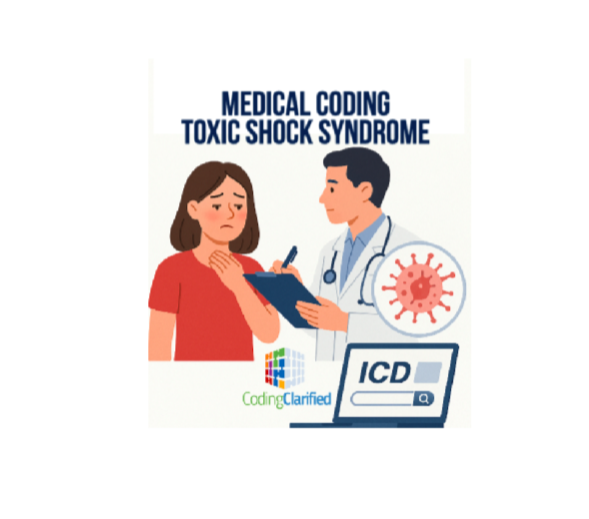Guidelines and Tips for Coding & Billing Toxic Shock Syndrome (TSS)
Toxic Shock Syndrome (TSS) is a rare but potentially life-threatening condition often caused by bacterial toxins. It requires prompt diagnosis, treatment, and accurate medical coding to ensure proper billing and reimbursement. This article outlines medical coding for toxic shock syndrome, key coding guidelines, and helpful tips for documenting and coding TSS correctly.
What is Toxic Shock Syndrome?
Toxic Shock Syndrome is most commonly associated with Staphylococcus aureus or Streptococcus pyogenes infections. It can result from tampon use, skin wounds, or surgical incisions. Symptoms include high fever, rash, low blood pressure, and multi-organ involvement.
Toxic Shock Syndrome (TSS) symptoms typically appear suddenly and worsen rapidly, often within a few days. In some cases, symptoms can develop as quickly as. If left 12 hours after a surgical procedure or within 3 to 5 days for menstruating individuals using tampons or menstrual cups, TSS can lead to organ failure and death within days.
-
Rapid Onset:
TSS symptoms, such as high fever, low blood pressure, vomiting, diarrhea, and a sunburn-like rash, tend to appear suddenly and escalate quickly.
-
Menstrual-related TSS:
For menstruating individuals using tampons or menstrual cups, symptoms can develop within 3 to 5 days.
-
Surgical-related TSS:
TSS following surgery can manifest as quickly as 12 hours post-procedure.
-
Importance of Prompt Treatment:
Due to the rapid progression of TSS, prompt diagnosis and treatment are crucial for a positive outcome.
-
Potential for Rapid Deterioration:Without treatment, TSS can lead to severe complications, including organ failure and death, within a short period, sometimes within 48 hours.
ICD-10-CM Coding for Toxic Shock Syndrome
-
Primary Code:
A48.3 – Toxic Shock Syndrome
Use this code when documentation clearly supports a diagnosis of TSS caused by either staphylococcal or streptococcal bacteria. -
Additional Codes (If Applicable):
Use B95.6 (Staphylococcus aureus) or B95.5 (Streptococcus pyogenes) as secondary codes to identify the infectious agent, if documented. -
Symptom Codes
Include relevant symptom codes (e.g., R50.9 for fever, R21 for rash) only when they are not integral to the condition or necessary for medical necessity.
ICD steps to code https://codingclarified.com/medical-coding-steps-for-icd-10-cm/
CPT Coding & Billing Tips
-
Inpatient Management
TSS often requires intensive inpatient care. Document all services, such as ICU admission, wound care, or procedures like mechanical ventilation (CPT codes 94002–94004). -
Outpatient Follow-up
Use E/M codes (e.g., 99214, 99215) for office visits addressing recovery or complications. -
Lab & Diagnostic Tests
If cultures or other tests are ordered to confirm infection, code separately using appropriate CPT codes (e.g., 87040 for culture, bacterial; aerobic).
CPT steps to code https://codingclarified.com/medical-coding-steps-for-cpt/
Documentation Tips
-
Ensure provider documentation explicitly states “Toxic Shock Syndrome” and the causative organism, if known.
-
Note any complications (renal failure, hypotension, respiratory distress).
-
Be thorough in describing severity, treatment, and site of infection to justify higher-level E/M services or procedures.
Common Coding Mistakes to Avoid
-
Do not confuse TSS with septicemia or general sepsis unless clearly documented.
-
Avoid undercoding by omitting secondary diagnoses (e.g., bacterial agent or complications).
-
Do not code presumptively – always base code selection on confirmed diagnoses or strong clinical evidence.
Key Takeaways
-
Use A48.3 for TSS and always code for the bacterial agent when available.
-
Document clearly and completely to support coding, medical necessity, and appropriate reimbursement.
-
Stay updated with payer-specific rules, as some may require additional documentation for inpatient claims involving TSS.
For more coding and billing insights, visit Coding Clarified and explore our educational resources and training programs.
Toxic shock syndrome (TSS)https://my.clevelandclinic.org/health/diseases/15437-toxic-shock-syndrome

